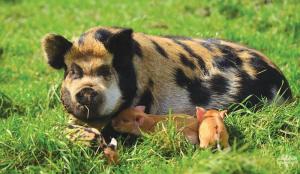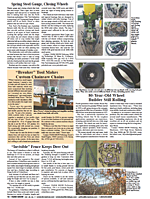2025 - Volume #49, Issue #5, Page #06
[ Sample Stories From This Issue | List of All Stories In This Issue | Print this story
| Read this issue]
Idaho Pasture Pigs Gaining Popularity
 |
“Idaho Pasture Pigs (IPP) were developed from KuneKune, Old Berkshire and Duroc pigs,” says IPP Registrar Jodi Cronauer. “Each breed brought something desirable to the mix, including the KuneKune’s upturned snout, which was important for their ability to graze. The Duroc added quicker growth and longer length, and the Berkshire added nicely marbled meat and a good mothering ability.”
Cronauer shares that the IPP was developed by Gary & Shelly Farris, who started selling breed stock in 2012.
“White Bison Farm purchased a trio in 2012 and had the pigs flown in from Idaho to Pennsylvania,” she says. “In 2013, the Farris’ decided to get out of raising pigs altogether, and White Bison Farm purchased the rest of their stock, including all the lineages. My husband Dave and I knew that the only hope of preserving this amazing breed was to start the Idaho Pasture Pigs Registry, so that’s what we did.”
The original goal was to create a good-natured animal that would graze rather than root, maturing out to a medium-sized pig. As a result, Idaho Pasture Pigs are hearty, medium-sized, and have good dispositions and mothering abilities.
“What makes Idaho Pasture Pigs stand out from similar breeds is their ability to graze and grow quickly on a primarily grass-based diet and to produce a better carcass at butcher time,” Cronauer says. “Combined with their pleasant personalities, they make the perfect homestead pig and are currently one of the most popular swine.”
She shares that the Registry works to uphold these breed standards.
“It amazes us how often we hear ‘this pig is perfect’ or ‘I hope no one ruins this breed like has happened to other breeds.’ That’s the goal of the Idaho Pasture Pig Registry— preserve this breed for years to come.”
Grass-fed meat is higher in omega-3 fats and more marbled than traditional pork. It’s known for its deep red coloring and sweeter flavor. Still, between 10% and 20% of the IPP’s diet should come from grains and minerals. A deficiency in minerals will cause the pigs to root in the ground to locate them, rather than grazing. Expect the boars to mature to 350 to 450 lbs. and the sows to 250 to 350 lbs. The breed will reach a butcher weight of 230 to 250 lbs. in approximately 10 mos.
Idaho Pasture Pigs are exceptionally friendly, with a calm and curious disposition. Any animals that show aggression should not be bred to keep the trait out of the gene pool. The upturned snout is key, as it allows the pigs to be efficient grazers. They tend to be hairier than other pigs, making them exceptionally cold-hardy. Likewise, IPP sows make excellent mothers and need minimal birth assistance. The average litter size is 5 to 7 for a first-time mom, and 8 to 10 thereafter.
Cronauer believes potential owners should seek to gain as much information as possible.
“Talk to owners and breeders in your area. You can find additional information on the breed itself, the breed standard, shelters, the importance of minerals in their diet, and connect with registered breeders on the IPPR website.”
Further information can also be found in Cronauer’s book, “Raising Pigs on Green Pastures.”
Contact: FARM SHOW Followup, Idaho Pasture Pigs Registry (IPPR), 711 Karls Ln., Laona, Wis. 54541 (ph 715-674-2287; idahopasturepigregistry@yahoo.com; www.idahopasturepigregistry.com) or Idaho Pasture Pig Breed Association (IPPBA) info@idahopasturepig.com; www.idahopasturepig.org).

Click here to download page story appeared in.

Click here to read entire issue
To read the rest of this story, download this issue below or click here to register with your account number.




